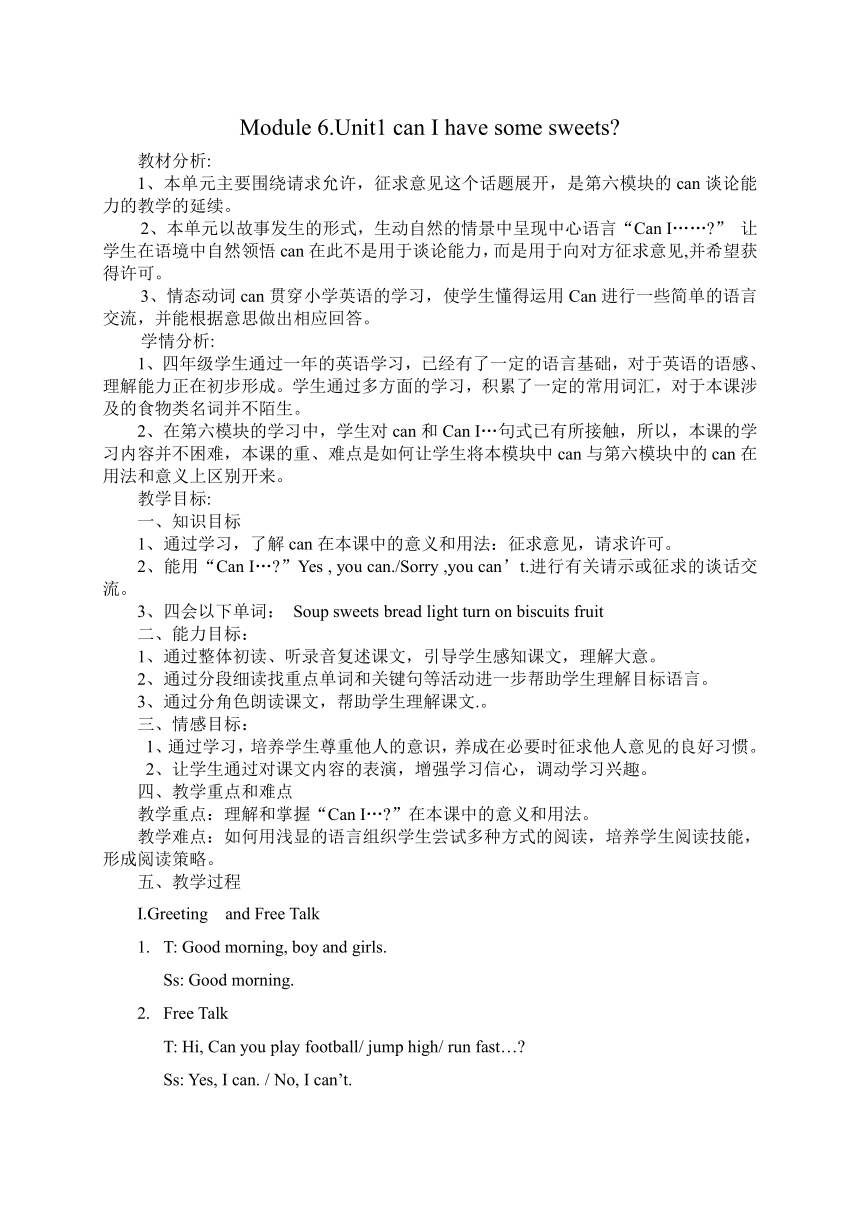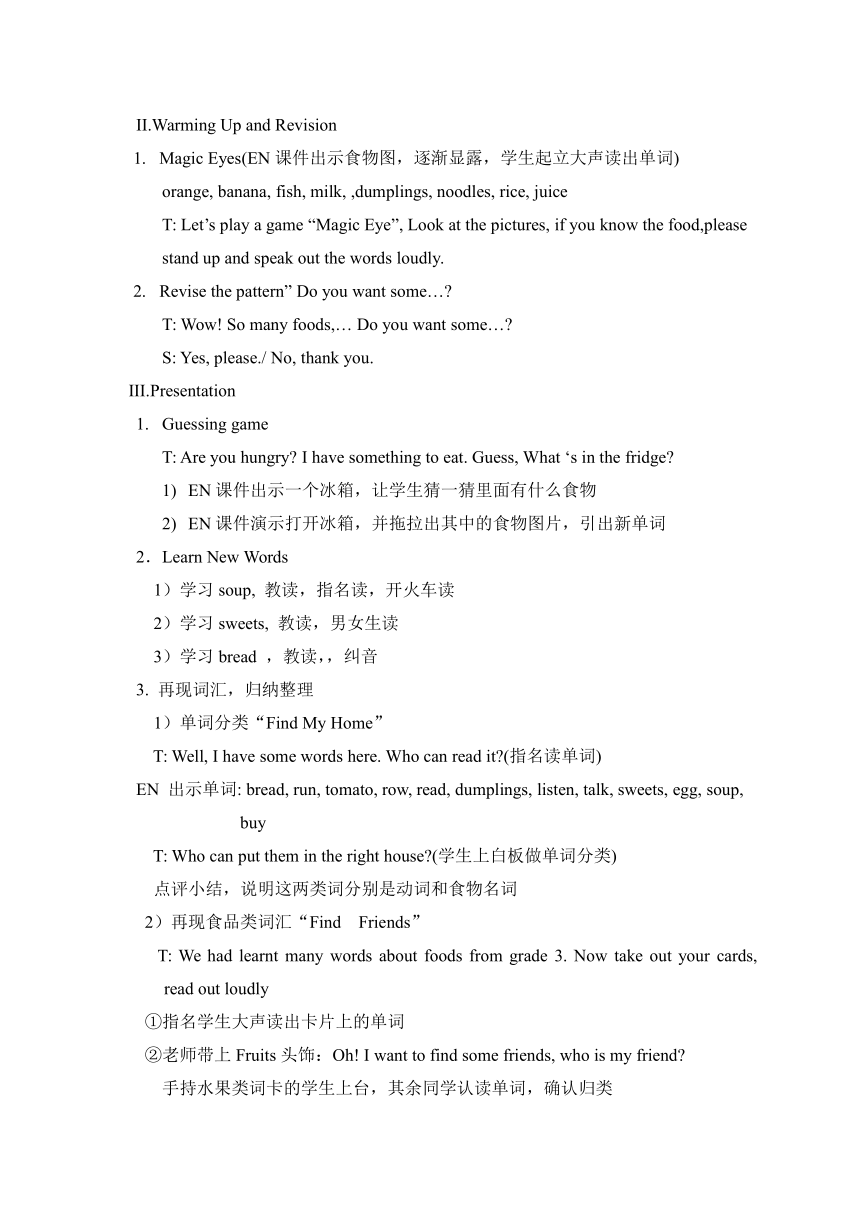Module 6 Unit can I have some sweets? 教案
文档属性
| 名称 | Module 6 Unit can I have some sweets? 教案 |

|
|
| 格式 | doc | ||
| 文件大小 | 46.0KB | ||
| 资源类型 | 教案 | ||
| 版本资源 | 外研版(三年级起点) | ||
| 科目 | 英语 | ||
| 更新时间 | 2022-09-22 20:13:24 | ||
图片预览


文档简介
Module 6.Unit1 can I have some sweets
教材分析:
1、本单元主要围绕请求允许,征求意见这个话题展开,是第六模块的can谈论能力的教学的延续。
2、本单元以故事发生的形式,生动自然的情景中呈现中心语言“Can I…… ” 让学生在语境中自然领悟can在此不是用于谈论能力,而是用于向对方征求意见,并希望获得许可。
3、情态动词can贯穿小学英语的学习,使学生懂得运用Can进行一些简单的语言交流,并能根据意思做出相应回答。
学情分析:
1、四年级学生通过一年的英语学习,已经有了一定的语言基础,对于英语的语感、理解能力正在初步形成。学生通过多方面的学习,积累了一定的常用词汇,对于本课涉及的食物类名词并不陌生。
2、在第六模块的学习中,学生对can和Can I…句式已有所接触,所以,本课的学习内容并不困难,本课的重、难点是如何让学生将本模块中can与第六模块中的can在用法和意义上区别开来。
教学目标:
一、知识目标
1、通过学习,了解can在本课中的意义和用法:征求意见,请求许可。
2、能用“Can I… ”Yes , you can./Sorry ,you can’t.进行有关请示或征求的谈话交流。
3、四会以下单词: Soup sweets bread light turn on biscuits fruit
二、能力目标:
1、通过整体初读、听录音复述课文,引导学生感知课文,理解大意。
2、通过分段细读找重点单词和关键句等活动进一步帮助学生理解目标语言。
3、通过分角色朗读课文,帮助学生理解课文.。
三、情感目标:
1、通过学习,培养学生尊重他人的意识,养成在必要时征求他人意见的良好习惯。
2、让学生通过对课文内容的表演,增强学习信心,调动学习兴趣。
四、教学重点和难点
教学重点:理解和掌握“Can I… ”在本课中的意义和用法。
教学难点:如何用浅显的语言组织学生尝试多种方式的阅读,培养学生阅读技能,形成阅读策略。
五、教学过程
I.Greeting and Free Talk
1. T: Good morning, boy and girls.
Ss: Good morning.
2. Free Talk
T: Hi, Can you play football/ jump high/ run fast…
Ss: Yes, I can. / No, I can’t.
II.Warming Up and Revision
1. Magic Eyes(EN课件出示食物图,逐渐显露,学生起立大声读出单词)
orange, banana, fish, milk, ,dumplings, noodles, rice, juice
T: Let’s play a game “Magic Eye”, Look at the pictures, if you know the food,please stand up and speak out the words loudly.
2. Revise the pattern” Do you want some…
T: Wow! So many foods,… Do you want some…
S: Yes, please./ No, thank you.
III.Presentation
1. Guessing game
1) T: Are you hungry I have something to eat. Guess, What ‘s in the fridge
2) EN课件出示一个冰箱,让学生猜一猜里面有什么食物
3) EN课件演示打开冰箱,并拖拉出其中的食物图片,引出新单词
2.Learn New Words
1)学习soup, 教读,指名读,开火车读
2)学习sweets, 教读,男女生读
3)学习bread ,教读,,纠音
3. 再现词汇,归纳整理
1)单词分类“Find My Home”
T: Well, I have some words here. Who can read it (指名读单词)
EN 出示单词: bread, run, tomato, row, read, dumplings, listen, talk, sweets, egg, soup, buy
T: Who can put them in the right house (学生上白板做单词分类)
点评小结,说明这两类词分别是动词和食物名词
2)再现食品类词汇“Find Friends”
T: We had learnt many words about foods from grade 3. Now take out your cards, read out loudly
①指名学生大声读出卡片上的单词
②老师带上Fruits头饰:Oh! I want to find some friends, who is my friend
手持水果类词卡的学生上台,其余同学认读单词,确认归类
③请两名同学上台来戴Dinner 和Drinks头饰继续“找朋友”
3)归纳小结,指导学生分类并巩固
T:Dinner, Drinks and Fruits are foods, Do you remember (EN课件出示思维导图,教师讲解)
4.Learn the key pattern
T:Oh. I’m hungry now. Can I have some… (提问手中拿有主食单词卡片的几位同学,引导学生答出答句)
Ss: Yes, you can./ No, you can’t.
1) EN 出示重点句型,带读句型
2) 学生利用手中的单词卡片。两两练习,教师巡视
T:Now please ask and answer with your friend, use the words cards in your hands.
3) Show Time
T: Who can show for us
指名学生展示
5.Learn the text
T:Today is Amy’s birthday. What happened in her birthday party and how many times did she ask for food
1) EN出示:Listen and think
1. How many times did Amy ask for food
2. What happened in Amy’s birthday party
2) Listen for the text
3) Answer the questions
①回答第一个问题时指导学生找出文中对应的三个句子,让学生在文中划出来
EN:Can I have some soup
Can I have some sweets, please
Can I have some bread
师生分角色读问句与答句
②回答第二个问题时相机教单词dark, well, turn on 和light
EN: dark art park party
Light right high
Turn on get on put on
利用已学的单词和词组的再现,引导学生归纳读音,加深记忆
4)Listen and repeat
T:Good job! Now please listen and repeat.
5)Read the text together
IV. Summary
T:Today we revised some words about fruits, drinks and dinner, they are all foods.
VI.Blackboard Design
Module 6
Unit.1 Can I have some sweets
Can I have some…
Yes, you can.
No, you can’t.
教材分析:
1、本单元主要围绕请求允许,征求意见这个话题展开,是第六模块的can谈论能力的教学的延续。
2、本单元以故事发生的形式,生动自然的情景中呈现中心语言“Can I…… ” 让学生在语境中自然领悟can在此不是用于谈论能力,而是用于向对方征求意见,并希望获得许可。
3、情态动词can贯穿小学英语的学习,使学生懂得运用Can进行一些简单的语言交流,并能根据意思做出相应回答。
学情分析:
1、四年级学生通过一年的英语学习,已经有了一定的语言基础,对于英语的语感、理解能力正在初步形成。学生通过多方面的学习,积累了一定的常用词汇,对于本课涉及的食物类名词并不陌生。
2、在第六模块的学习中,学生对can和Can I…句式已有所接触,所以,本课的学习内容并不困难,本课的重、难点是如何让学生将本模块中can与第六模块中的can在用法和意义上区别开来。
教学目标:
一、知识目标
1、通过学习,了解can在本课中的意义和用法:征求意见,请求许可。
2、能用“Can I… ”Yes , you can./Sorry ,you can’t.进行有关请示或征求的谈话交流。
3、四会以下单词: Soup sweets bread light turn on biscuits fruit
二、能力目标:
1、通过整体初读、听录音复述课文,引导学生感知课文,理解大意。
2、通过分段细读找重点单词和关键句等活动进一步帮助学生理解目标语言。
3、通过分角色朗读课文,帮助学生理解课文.。
三、情感目标:
1、通过学习,培养学生尊重他人的意识,养成在必要时征求他人意见的良好习惯。
2、让学生通过对课文内容的表演,增强学习信心,调动学习兴趣。
四、教学重点和难点
教学重点:理解和掌握“Can I… ”在本课中的意义和用法。
教学难点:如何用浅显的语言组织学生尝试多种方式的阅读,培养学生阅读技能,形成阅读策略。
五、教学过程
I.Greeting and Free Talk
1. T: Good morning, boy and girls.
Ss: Good morning.
2. Free Talk
T: Hi, Can you play football/ jump high/ run fast…
Ss: Yes, I can. / No, I can’t.
II.Warming Up and Revision
1. Magic Eyes(EN课件出示食物图,逐渐显露,学生起立大声读出单词)
orange, banana, fish, milk, ,dumplings, noodles, rice, juice
T: Let’s play a game “Magic Eye”, Look at the pictures, if you know the food,please stand up and speak out the words loudly.
2. Revise the pattern” Do you want some…
T: Wow! So many foods,… Do you want some…
S: Yes, please./ No, thank you.
III.Presentation
1. Guessing game
1) T: Are you hungry I have something to eat. Guess, What ‘s in the fridge
2) EN课件出示一个冰箱,让学生猜一猜里面有什么食物
3) EN课件演示打开冰箱,并拖拉出其中的食物图片,引出新单词
2.Learn New Words
1)学习soup, 教读,指名读,开火车读
2)学习sweets, 教读,男女生读
3)学习bread ,教读,,纠音
3. 再现词汇,归纳整理
1)单词分类“Find My Home”
T: Well, I have some words here. Who can read it (指名读单词)
EN 出示单词: bread, run, tomato, row, read, dumplings, listen, talk, sweets, egg, soup, buy
T: Who can put them in the right house (学生上白板做单词分类)
点评小结,说明这两类词分别是动词和食物名词
2)再现食品类词汇“Find Friends”
T: We had learnt many words about foods from grade 3. Now take out your cards, read out loudly
①指名学生大声读出卡片上的单词
②老师带上Fruits头饰:Oh! I want to find some friends, who is my friend
手持水果类词卡的学生上台,其余同学认读单词,确认归类
③请两名同学上台来戴Dinner 和Drinks头饰继续“找朋友”
3)归纳小结,指导学生分类并巩固
T:Dinner, Drinks and Fruits are foods, Do you remember (EN课件出示思维导图,教师讲解)
4.Learn the key pattern
T:Oh. I’m hungry now. Can I have some… (提问手中拿有主食单词卡片的几位同学,引导学生答出答句)
Ss: Yes, you can./ No, you can’t.
1) EN 出示重点句型,带读句型
2) 学生利用手中的单词卡片。两两练习,教师巡视
T:Now please ask and answer with your friend, use the words cards in your hands.
3) Show Time
T: Who can show for us
指名学生展示
5.Learn the text
T:Today is Amy’s birthday. What happened in her birthday party and how many times did she ask for food
1) EN出示:Listen and think
1. How many times did Amy ask for food
2. What happened in Amy’s birthday party
2) Listen for the text
3) Answer the questions
①回答第一个问题时指导学生找出文中对应的三个句子,让学生在文中划出来
EN:Can I have some soup
Can I have some sweets, please
Can I have some bread
师生分角色读问句与答句
②回答第二个问题时相机教单词dark, well, turn on 和light
EN: dark art park party
Light right high
Turn on get on put on
利用已学的单词和词组的再现,引导学生归纳读音,加深记忆
4)Listen and repeat
T:Good job! Now please listen and repeat.
5)Read the text together
IV. Summary
T:Today we revised some words about fruits, drinks and dinner, they are all foods.
VI.Blackboard Design
Module 6
Unit.1 Can I have some sweets
Can I have some…
Yes, you can.
No, you can’t.
同课章节目录
- Module 1
- Unit 1 Go straight on.
- Unit 2 It's at the station.
- Module 2
- Unit 1 She's reading a book.
- Unit 2 What are you doing?
- Module 3
- Unit 1 What are they doing?
- Unit 2 What's the elephant doing?
- Module 4
- Unit 1 Do you want some rice?
- Unit 2 How much is it?
- Module 5
- Unit 1 Can you ran fast?
- Unit 2 Can Sam play football?
- Module 6
- Unit 1 Can I have some sweets?
- Unit 2 Happy Halloween!
- Module 7
- Unit 1 There is a horse in this photo.
- Unit 2 There are twelve boys on the bike.
- Module 8
- Unit 1 We're going to visit Hainan.
- Unit 2 Sam is going to ride horse.
- Module 9
- Unit 1 Are you going to run on Sports Day?
- Unit 2 I'm going to do the high jump.
- Module 10
- Unit 1 We have a big family dinner.
- Unit 2 Merry Christmas!
- Review Module
- Unit 1
- Unit 2
